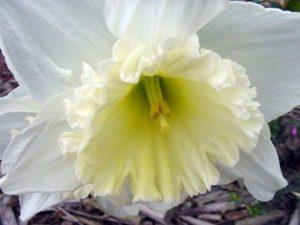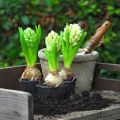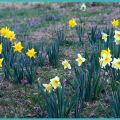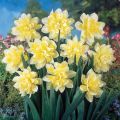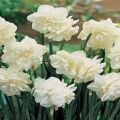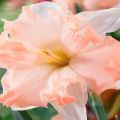Do you need to dig up daffodils every year, timing, care and storage
Often, beautiful flowers such as daffodils can be seen in home gardens. Their beauty is sung in ancient legends about a beautiful young man who starved to death while admiring his own reflection. Delicate flowers require proper care. But not everyone knows whether it is necessary to dig out daffodils after flowering for the winter cold season, as well as other important rules for digging and storing bulbs in winter.
Content
- 1 Do I need to dig up daffodils
- 2 Why wintering is destructive for daffodils
- 3 When it's time to dig
- 4 What else you need to know about digging up daffodils after flowering
- 5 The need for the procedure every year
- 6 Digging Precautions
- 7 How to store daffodil bulbs correctly
- 8 When to plant daffodils back in the ground
Do I need to dig up daffodils
To determine how often you need to dig the bulbs out of the soil, you need to pay attention to the following facts:
- Several babies grow on each flower bulb every year. This makes it possible for lovers of daffodils in a short time to significantly increase the number of tubers on their land plot.
- If not transplanted for 5 years, the bulbs will grow close to each other, and this negatively affects the flowering of daffodils. Therefore, it is recommended to periodically divide the roots and transplant the plant.
- Flowers tolerate the cold season easily, so there is no need to dig up the bulbs for winter storage. Most of the growers every year get the rhizomes from the soil for routine inspection and reproduction.
- When caring for daffodils, you need to pay attention to the size of the bud. If the flower becomes small, and the plant seems sluggish and weak, this signals possible diseases of the bulbs. In this case, after the flowering period, the tubers need to be dug up, inspected, disinfected the root system and removed the infected areas.
Experienced flower growers advise against getting daffodil bulbs out of the ground every year, without good reason. Since with frequent transplantation, the plant can stop flowering for several seasons or release small buds.
Why wintering is destructive for daffodils
Almost all types of this beautiful flower tolerate cold weather perfectly, being outdoors, and do not need to be stored outside the flower bed. It is recommended to cover with a small layer of mulch and dry leaves only in case of transplanting or changing the place of flowering of the plant.
Tacetous varieties need mulching every year. Terry and imported daffodils require the same care. Mulching helps to preserve the tubers also in the absence of rainfall.Therefore, experienced flower growers recommend using this method of protection during the winter months, even for hybrid flower varieties that are highly frost-resistant.
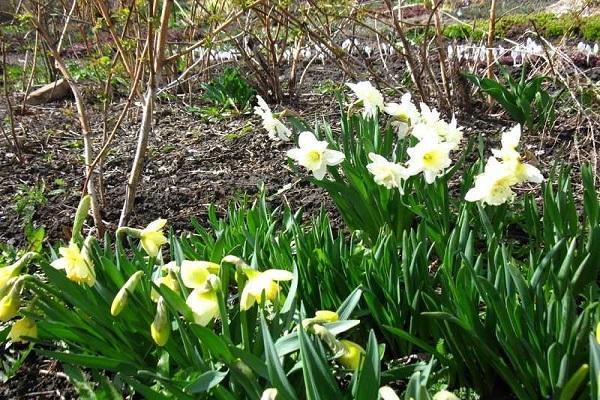
When it's time to dig
When the time has come for transplanting daffodils, in order to avoid the lack of flowering in the new season, it is necessary to accurately determine the time for digging the tubers.
Unlike other flowering plants, daffodils do not have a specific time for the dormant stage, that is, a period when all processes inside the flower slow down significantly. Therefore, the owners of this plant do not have to wait for a specific day to start the transplant procedure.
However, it is not recommended to do this immediately after the buds are blooming. The best time is considered the moment when the leaves of the daffodils completely turn yellow. This usually occurs in the second half of June and continues until early July.
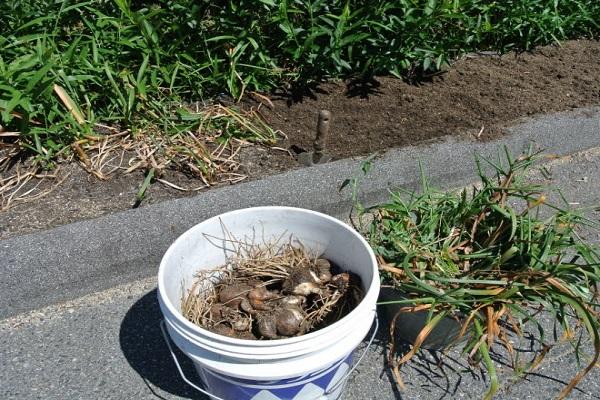
What else you need to know about digging up daffodils after flowering
When the buds of beautiful flowers have ceased to please the eye, the leaves have acquired a dark yellow hue, and it's time to get the tubers out of the ground - the next stage of plant care begins. Cut the wilted leaves, then move the dug out bulbs to a cool and well-ventilated place to dry. After that, shake off the dried remains of the earth from the roots.
The need for the procedure every year
It is recommended to dig up and store the bulbs of daffodils after flowering only in cases where the grower plans to transplant or propagate the plant. And also when there is a suspicion of the presence of diseases of the root system.
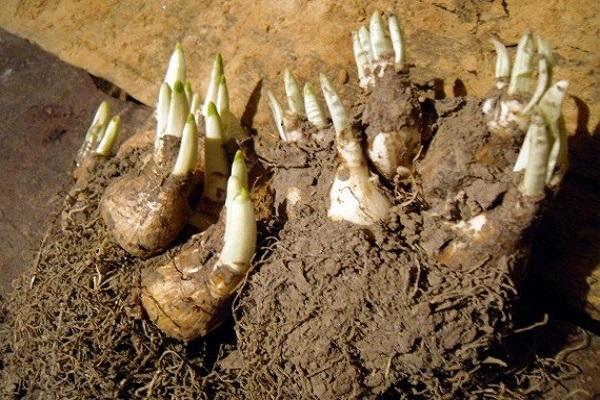
Digging Precautions
Basic recommendations for the safe extraction of rhizomes from the soil:
- It is necessary to dig up the bulbs of plants together with a large clod of earth so as not to harm them.
- It is undesirable to use a large garden shovel as there is a high chance of damaging the roots. Better to use a tool designed for indoor plants.
- In no case should you cut the roots.
- After the tubers have dried up a little, it is required to recapture excess soil and start dividing the bulbs. This part of the plant is quite sensitive, so this procedure must be approached with great care.
Attention! In order to remove excess soil, you should not resort to using water. If, of all the tubers dug for transplant, at least one onion is sick, it is highly likely that all the others will be infected.
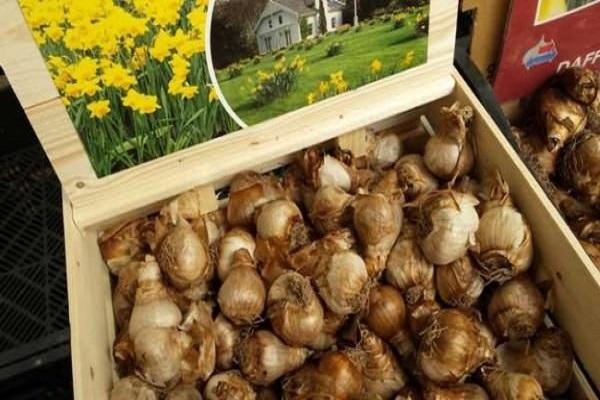
How to store daffodil bulbs correctly
To save the dug bulbs until spring without harming them, several recommendations should be followed.
Daffodils should be laid out in the open air and allowed to dry well. It is required to avoid direct sunlight on the plant, as it can be burned. It is also undesirable to keep the bulbs outdoors during the summer rains.
After the flowers are completely dry, they are moved to a cool and ventilated area until planting.
Choosing a storage location
For this, a cellar, a shed and other household buildings are suitable. The only thing you need to pay attention to is the air temperature in the storage, it should not exceed 15-16 degrees Celsius.
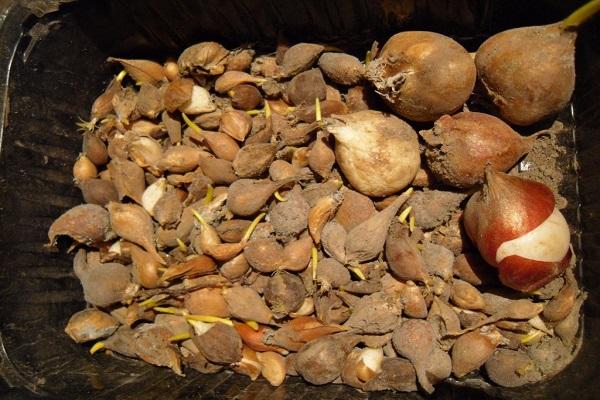
It should be noted that flowers need constant air circulation during storage at home. Therefore, they are placed in open boxes or boxes, laid out in rows. It is strongly not recommended to use plastic bags for storing daffodil bulbs.
You should check daffodils about once every 7-10 days.If it becomes noticeable that some of the onions have begun to rot or are infected with any fungi or pests, they are removed so that the diseases do not spread to healthy roots.
Attention! It is not recommended to store tubers at home in winter for more than 120 days, otherwise the planting material will begin to actively deteriorate.
Do you need processing
Immediately before planting, it is advisable to process the plants in order to eliminate the risk of infection with parasites. To do this, all the bulbs are placed in a container with potassium permanganate of low concentration for no more than half an hour. Also, for these purposes, you can use special store drugs, such as Fitosporin or Maxim Dachnik. The rules for processing with these agents are described on the packaging.
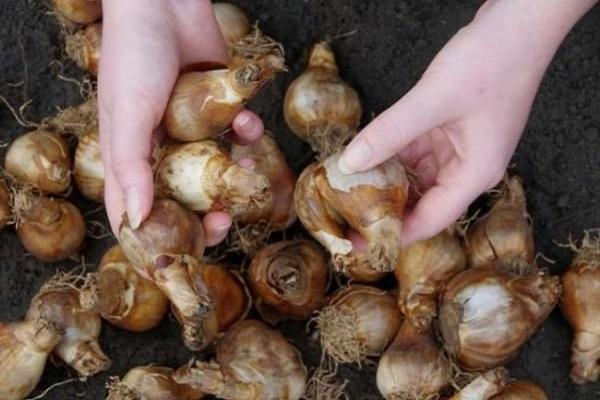
When to plant daffodils back in the ground
If there is a desire to see the buds in the next season, then the planting material must be sent to the ground in the fall. However, you need to pay attention to weather conditions and precipitation. It is advisable to have time to plant the bulbs three to four weeks before the onset of the first frost, so that they take root in the hole.
Another important point is that the air temperature before landing should not drop below +10 degrees for several weeks. In the middle climatic zone, it is recommended to plant daffodils in the second decade of September. As for those regions of the country where frosts come earlier, and the climate is more severe (Urals and Siberia), planting in open ground must be carried out at the end of summer.
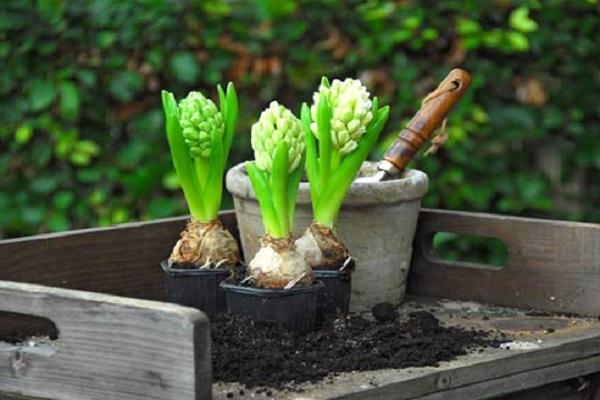
If a decision is made to plant daffodils in the spring, it is necessary to choose the period of time when the soil warmed up to 7 degrees Celsius. Often, this is mid-April, early May - depending on the region. But it should be remembered that there will be no flowering this season, since the plant needs to take root.
Regardless of the period in which the daffodils were planted, so that they decorate the flower bed annually and please the eye, it is required to be wise when choosing a site for the garden. And also properly prepare the ground.
It is advisable to choose a higher place for planting flowers, since the bulbs will quickly rot due to high humidity. It is also better to choose areas of the garden that are open to the sun and calm.
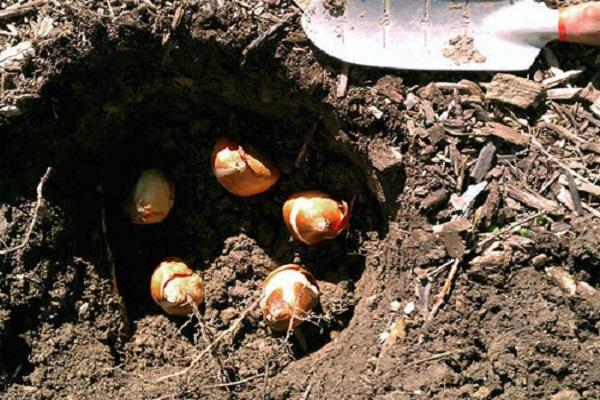
The soil is prepared in advance before planting. Depending on the type of soil, different feeding is suitable:
- Heavy soil is diluted with sand and humus, as well as compost.
- If the acidity of the soil is increased, it is recommended to use wood ash or limestone flour for fertilization.
- Complex fertilizer - superphosphate is suitable for all types of soil.
Bulbous flowers require drainage. To do this, a little sand is poured at the bottom of the hole, so that water does not stagnate in the root system of the plant.
